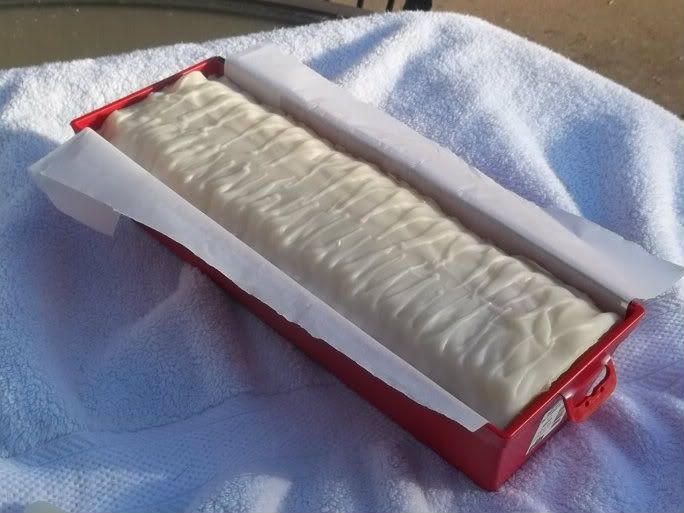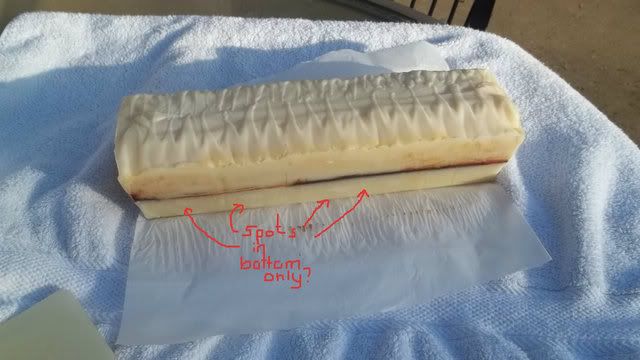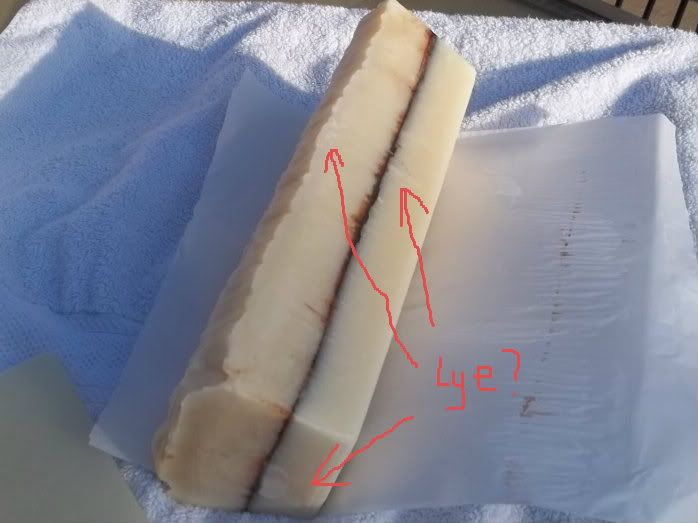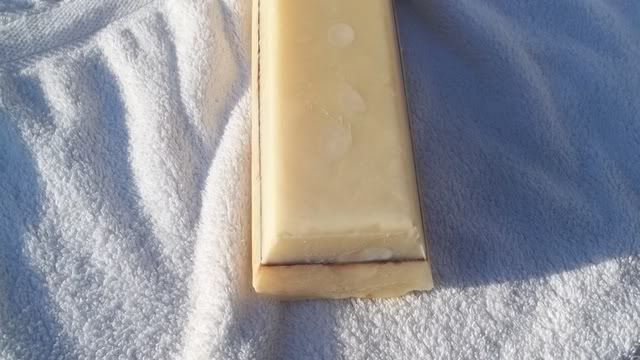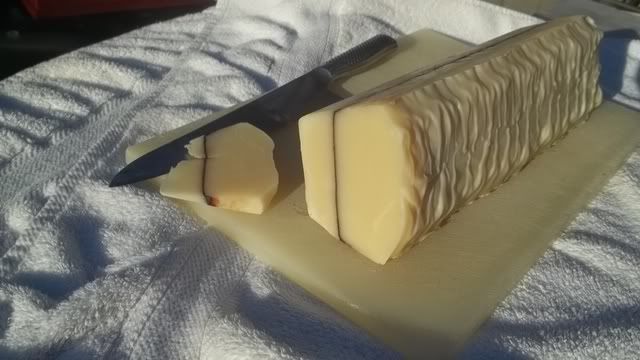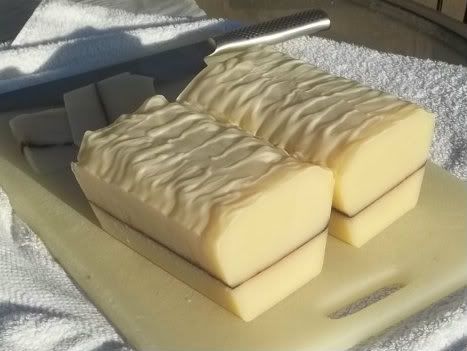Suisan2
Well-Known Member
Whoa, I made a crazy batch of soap yesterday afternoon. It's still in the mold, so no pictures yet, but this one's behaving oddly.
My husband's a butcher; he runs his own high-end "All-Natural", no-hormones added, locally sourced butcher shop. Over the past few months, he's been bringing in a few whole hogs, breaking them, selling some of the delicacies to his preferred customer list, rendering the lard, and selling it.
His customers have been raving about the lard in pie crust. I'm fairly famous for my butter/shortening pie crust -- when I tried to make pie crust with this lard, I found it to be very wet. Flour + chilled lard almost made a pie crust on its own. I asked him about forcing more water out of the lard, and he said he was following the direction of two other "old-time" butchers. They render it over heat very slowly and filter out the cracklings.
This is fat from the whole hog, not just fatback or leaf lard. It's much creamier, even when chilled, than I had expected. It acts like softened butter.
Using SoapCalc, I put together a recipe for a lard/olive oil soap, using up a bit of palm oil and ghee I had left over and a dash of castor oil (trying to clean out some oils before expiration date). I'm also trying to figure out what weight of oils my mold will hold. Using those ideas, I came up with this recipe:
Olive Oil: 35.66% 612 g
Lard: 26.81% 460g
Shea Butter: 11.66% 200g
Ghee: 9.73% 167g
Castor Oil: 10.49% 180g
Palm Oil (all that I had): 5.65% 97g
Total weight of oil--> 1716
Water as percent of oil 38%
Superfat 9%
Distilled water 652.08g
Lye (NaOH): 215.916g
To this I added a bit of cardamon essential oil from Brambleberry -- just about 2 g. I didn't want it to seize, but I wanted it lightly scented in case the lard carried a smell.
Everything mixed well, but the ghee had a hard time melting in the presence of lye. I ended up putting the pot of oils and lye on the burner (very low) to force the ghee to melt. Temp got up to about 150! Yikes. (Not interested in doing THAT again.) After fats were melted, I put the pot on a cool water filled sink and added OO and castor oil.
From then on, everything worked well. Took a long time to reach trace, but it did eventually, and adding the cardamom didn't make anything seize. I poured into my mold, did some decorating, covered, and wrapped it in towels.
I checked it at about five hours -- it was fully set up, and when I touched the top with my finger there was a faint greasy feel, but no oil on the sides or top. I had been expecting it to be quite hot, but the side of the mold was only barely warm to the touch. Did a zap test -- kaPOW!. Ahem. OK, so I figured that I was being obsessive by checking it this early (My last batch of OO only set up so quickly that it was hard to cut, and my previous batch of OO, Palm, CO almost overheated.) and that I'd recheck it in the morning.
This morning (12 hours from molding), it looks no different than last night, but it is much warmer. I haven't zap tested it, because I guess it's just going through a really long gel? Once it cools, I'll zap test again.
Both the olive oil and the lard were free, so if this is a disaster loaf, then it's fine. I've got notes and the learning experience.
Question is this -- I think the lard may have too much water in it judging from my own experience with it when making pie crust. (Moisture in oil --> extra lye) How do you drive more moisture out of the lard to make it harder and whiter? Or, does anyone have a SAP value for bacon grease? The texture of this product is more like bacon grease, without that strong scent.
If it's a disaster, I guess I could try saving it by rebatching, but how much oil would I add? I don't know how much extra lye is likely to be in the soap. Hmmm.
Once I unmold, I'll post pictures.
--------
(My husband's customers LOVE this lard and it's selling at a premium price, so I don't really need to use it up. However, he may bring in sides of beef in the future and he doesn't expect the tallow to move at all. I'm playing with the "homemade" lard now in preparation of having to deal with "homemade" tallow in the future.)
My husband's a butcher; he runs his own high-end "All-Natural", no-hormones added, locally sourced butcher shop. Over the past few months, he's been bringing in a few whole hogs, breaking them, selling some of the delicacies to his preferred customer list, rendering the lard, and selling it.
His customers have been raving about the lard in pie crust. I'm fairly famous for my butter/shortening pie crust -- when I tried to make pie crust with this lard, I found it to be very wet. Flour + chilled lard almost made a pie crust on its own. I asked him about forcing more water out of the lard, and he said he was following the direction of two other "old-time" butchers. They render it over heat very slowly and filter out the cracklings.
This is fat from the whole hog, not just fatback or leaf lard. It's much creamier, even when chilled, than I had expected. It acts like softened butter.
Using SoapCalc, I put together a recipe for a lard/olive oil soap, using up a bit of palm oil and ghee I had left over and a dash of castor oil (trying to clean out some oils before expiration date). I'm also trying to figure out what weight of oils my mold will hold. Using those ideas, I came up with this recipe:
Olive Oil: 35.66% 612 g
Lard: 26.81% 460g
Shea Butter: 11.66% 200g
Ghee: 9.73% 167g
Castor Oil: 10.49% 180g
Palm Oil (all that I had): 5.65% 97g
Total weight of oil--> 1716
Water as percent of oil 38%
Superfat 9%
Distilled water 652.08g
Lye (NaOH): 215.916g
To this I added a bit of cardamon essential oil from Brambleberry -- just about 2 g. I didn't want it to seize, but I wanted it lightly scented in case the lard carried a smell.
Everything mixed well, but the ghee had a hard time melting in the presence of lye. I ended up putting the pot of oils and lye on the burner (very low) to force the ghee to melt. Temp got up to about 150! Yikes. (Not interested in doing THAT again.) After fats were melted, I put the pot on a cool water filled sink and added OO and castor oil.
From then on, everything worked well. Took a long time to reach trace, but it did eventually, and adding the cardamom didn't make anything seize. I poured into my mold, did some decorating, covered, and wrapped it in towels.
I checked it at about five hours -- it was fully set up, and when I touched the top with my finger there was a faint greasy feel, but no oil on the sides or top. I had been expecting it to be quite hot, but the side of the mold was only barely warm to the touch. Did a zap test -- kaPOW!. Ahem. OK, so I figured that I was being obsessive by checking it this early (My last batch of OO only set up so quickly that it was hard to cut, and my previous batch of OO, Palm, CO almost overheated.) and that I'd recheck it in the morning.
This morning (12 hours from molding), it looks no different than last night, but it is much warmer. I haven't zap tested it, because I guess it's just going through a really long gel? Once it cools, I'll zap test again.
Both the olive oil and the lard were free, so if this is a disaster loaf, then it's fine. I've got notes and the learning experience.
Question is this -- I think the lard may have too much water in it judging from my own experience with it when making pie crust. (Moisture in oil --> extra lye) How do you drive more moisture out of the lard to make it harder and whiter? Or, does anyone have a SAP value for bacon grease? The texture of this product is more like bacon grease, without that strong scent.
If it's a disaster, I guess I could try saving it by rebatching, but how much oil would I add? I don't know how much extra lye is likely to be in the soap. Hmmm.
Once I unmold, I'll post pictures.
--------
(My husband's customers LOVE this lard and it's selling at a premium price, so I don't really need to use it up. However, he may bring in sides of beef in the future and he doesn't expect the tallow to move at all. I'm playing with the "homemade" lard now in preparation of having to deal with "homemade" tallow in the future.)





